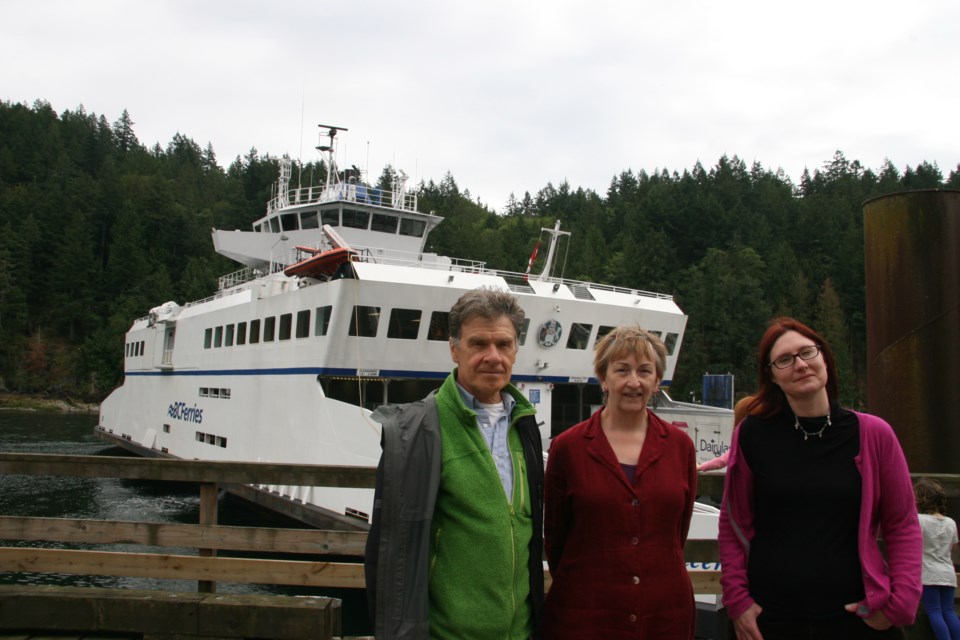Better communication, a lower buy-in for the Experience Card and, most importantly, the reinstating of some lost weekend sailings, drove the conversation during a biannual sitdown in mid-June between Bowen’s ferry advisory committee and B.C. Ferries.
There is an increase in families moving to the island, said Bowen Island Councilor Melanie Mason, creating a growing need for more ferry service. The elimination of two sailings from the Bowen route in 2014 has caused some stress, according to a recent survey put out by the ferry advisory committee and responded to by 10 per cent of islanders.
“The survey showed that it is also creating hardship for shift workers or those having to work on the weekend,” said Mason, who is also a FAC member.
The axed 7:30 a.m. Saturday sailing is having the biggest impact, said ferry advisory committee chair Susanna Braund.
“If you need to be in the city for nine o’clock in the morning for your kid’s game, the 8:30 (sailing) won’t get you there on time - you have to get the 6:30 (sailing) on a Saturday morning,” said Braund. “So that’s one we would really like to have back on, and we think that B.C. Ferries might be open to that if we move a sailing from somewhere else in the schedule.”
Looking at the survey results, sailings identified as being the least popular are mid-morning during the weekdays, the 11:30 a.m. from Snug Cove for example, said Braund.
B.C. Ferries manager of public affairs Darin Guenette said the company is open to reworking Bowen’s ferry schedule to suit the community, but won’t be adding any more sailings at this point.
Any case for additional sailings must be made to the province by Bowen’s FAC and on the basis of economic grounds, such as a demographic change, said Braund.
In 2014, B.C. Ferries was given direction by the Ministry of Transportation and Infrastructure, said Guenette, to look at sailings across the board and reduce some of those with lower traffic volumes.
Each ferry route had a savings target and Bowen’s was $270,000. The savings came from a reduction in crew dates and fuel, explained Guenette.
The FAC is pressing hard for a lower minimum buy-in for the Experience Card, said Braund, for the benefit of those who can’t afford to prepay $115.
B.C. Ferries sets the minimum buy-in as the price of two fares for the most expensive route that you can use the Experience Card.
“We don’t want it be a single-use card,” explained Guenette.
While the FAC is calling for a Bowen-specific Experience Card, Guenette said there are no planned changes at the moment for that discount system, explaining one of the challenges is that ferry travellers wouldn’t be able to use that card on the other routes.
Better communication from B.C. Ferries personnel after regular business hours is a perennial ask from the FAC. Braund said service email notifications are “erratic” and when the ferry is operating on a “load-and-go” basis because it’s running late, for example, - that needs to be communicated to travellers.
On the B.C. Ferries website there is a way to track where the vessel is at any given time, explained Guenette, adding load-and-go cases aren’t that common on the Bowen route.
Bowen council recently passed a resolution that would bring ferry flaggers in the summer to Snug Cove. Guenette said B.C. Ferries is willing to consider cost-sharing for that initiative.
Once the flaggers are in place, said Guenette, that might be the time to look at double-lane loading - which is in the works on a trial basis for Snug Cove.
While there’s no roll-out date yet, Guenette said making use of two lanes for loading can save a couple minutes and help keep the ferry on schedule.
“We said, ‘Yeah, we can look at this (double-lane loading).’ Our crew can do it. We do it at Horseshoe Bay. So the crew is comfortable with getting cars off and on.”
The FAC also raised concerns about large walk-on groups coming from Horseshoe Bay that puts the ferry at its legal maximum number of passengers, thereby leaving numerous vehicles behind, explained Braund.
“They (B.C. Ferries) do know when they have put a big group on the ferry at Horseshoe Bay,” said Braund. So, they need to be aware of that and think ahead. So what we would really like them to do is put on the extra crew for the afternoon when they have put on a big group of walkers in the morning.”
Guenette said those events, where the Queen of Capilano maximizes the amount of passengers she can take, happen less than a handful of times a year.
The meeting also allowed an opportunity for the FAC to thank B.C. Ferries for recent Snug Cove improvements including new functional bike racks, some cleanup of vegetation and use of fill to increase the area beside the washrooms.
While discussions for a new heated shelter with incorporated washrooms are still two years away, the FAC said it’s pleased to see the project is part of B.C. Ferries capital planning schedule.



